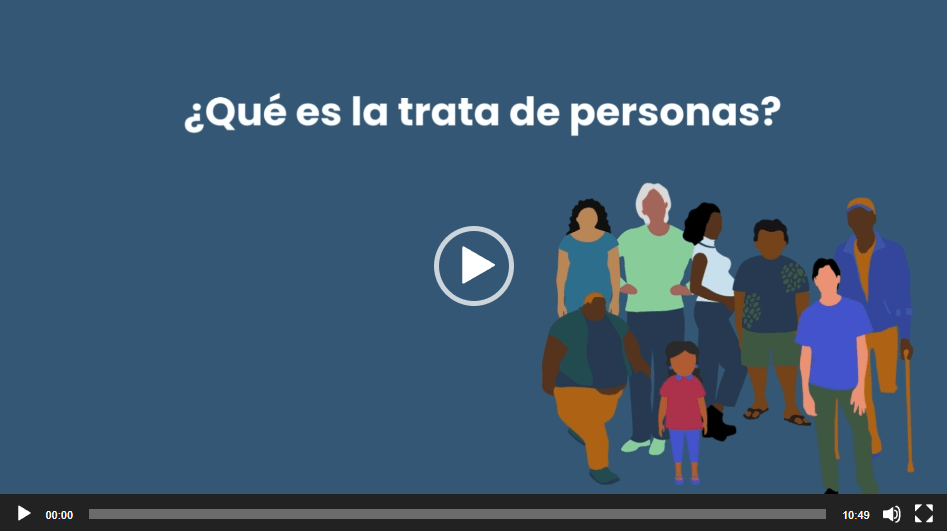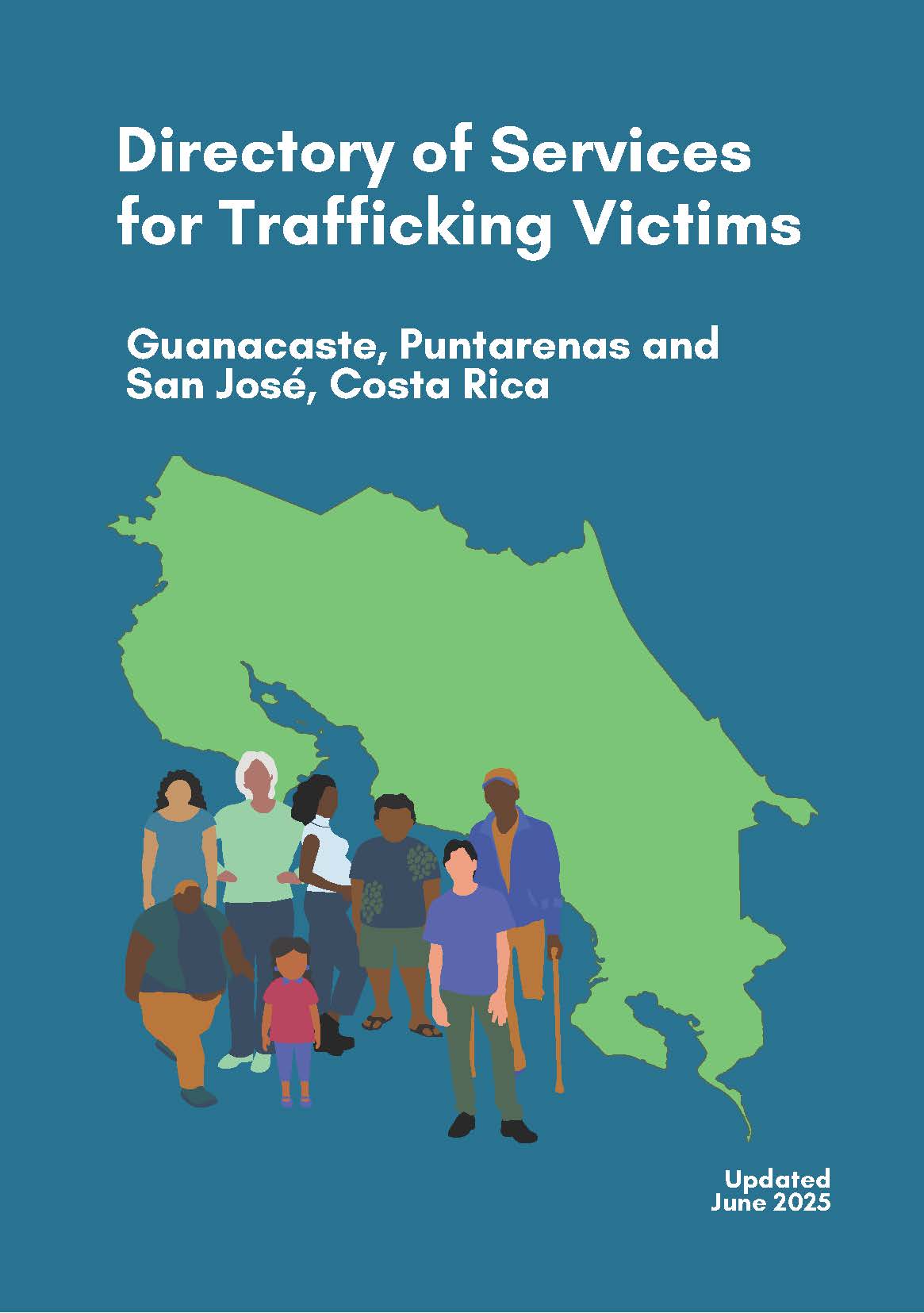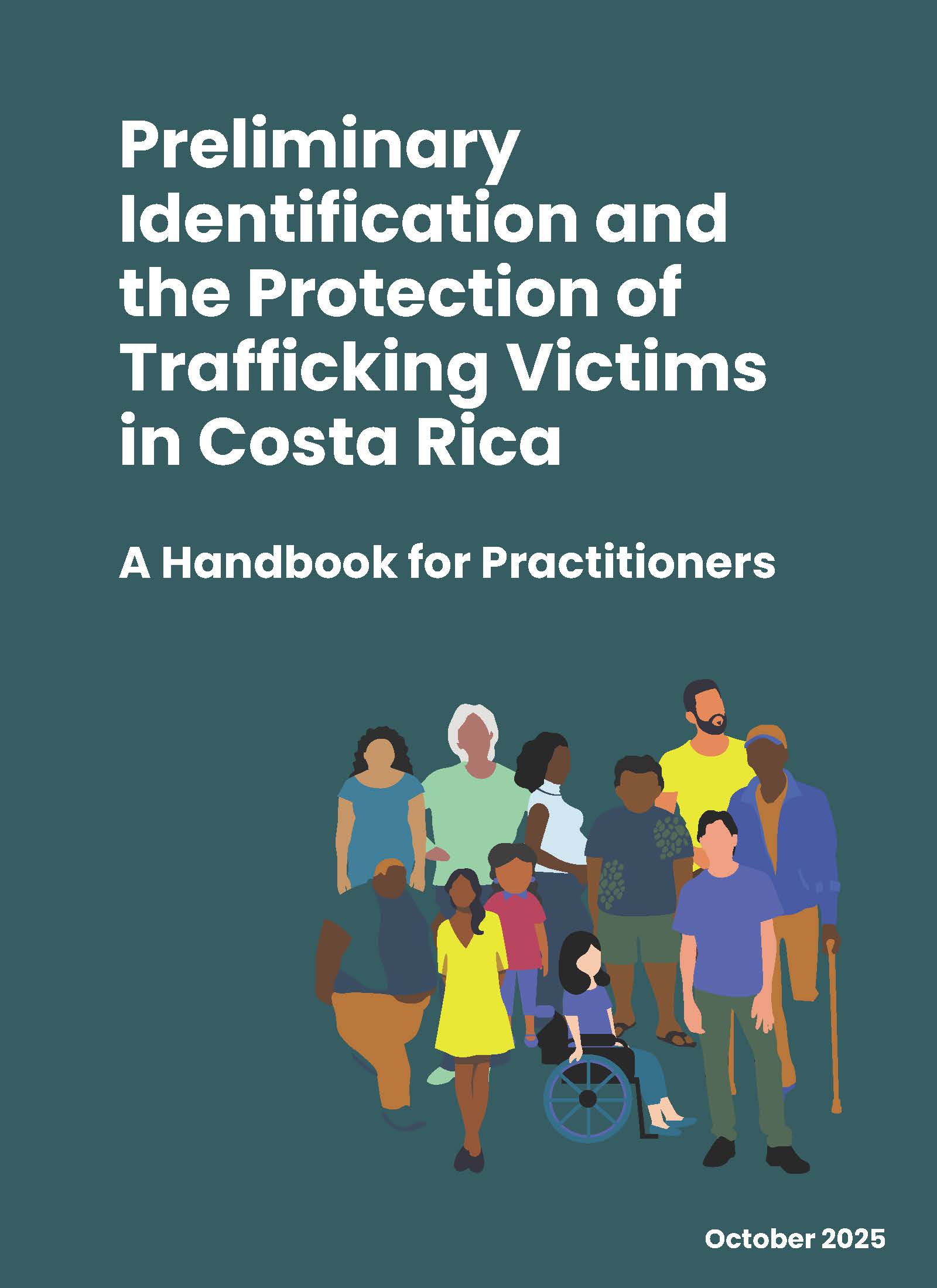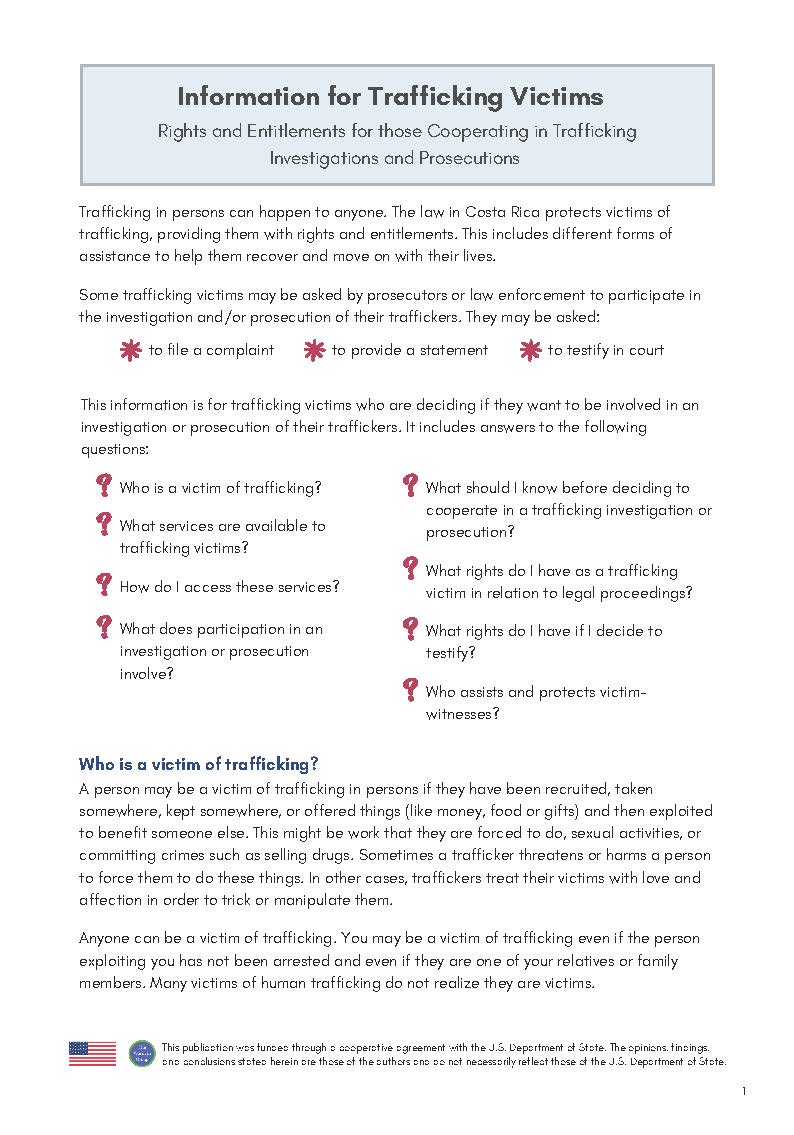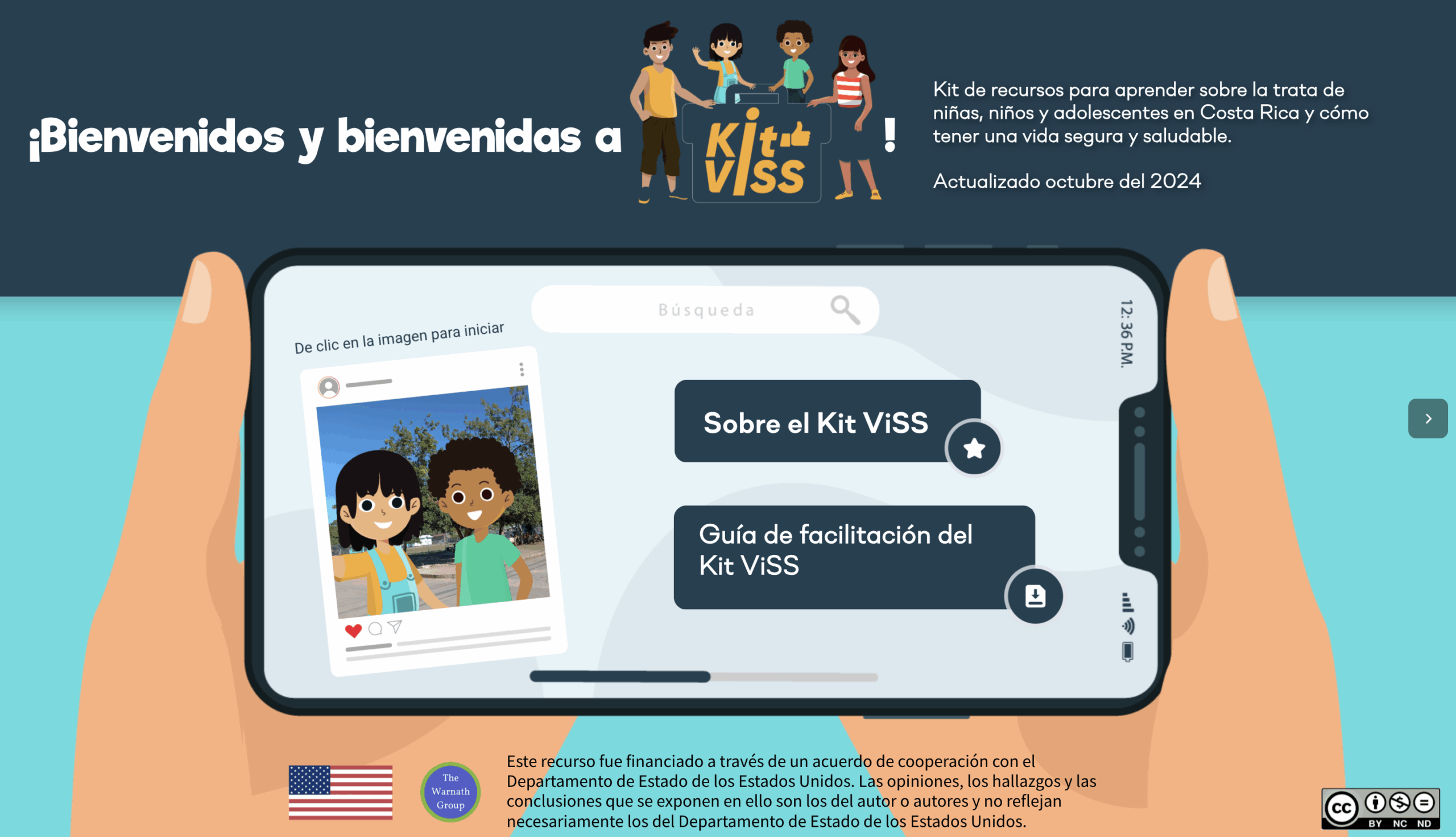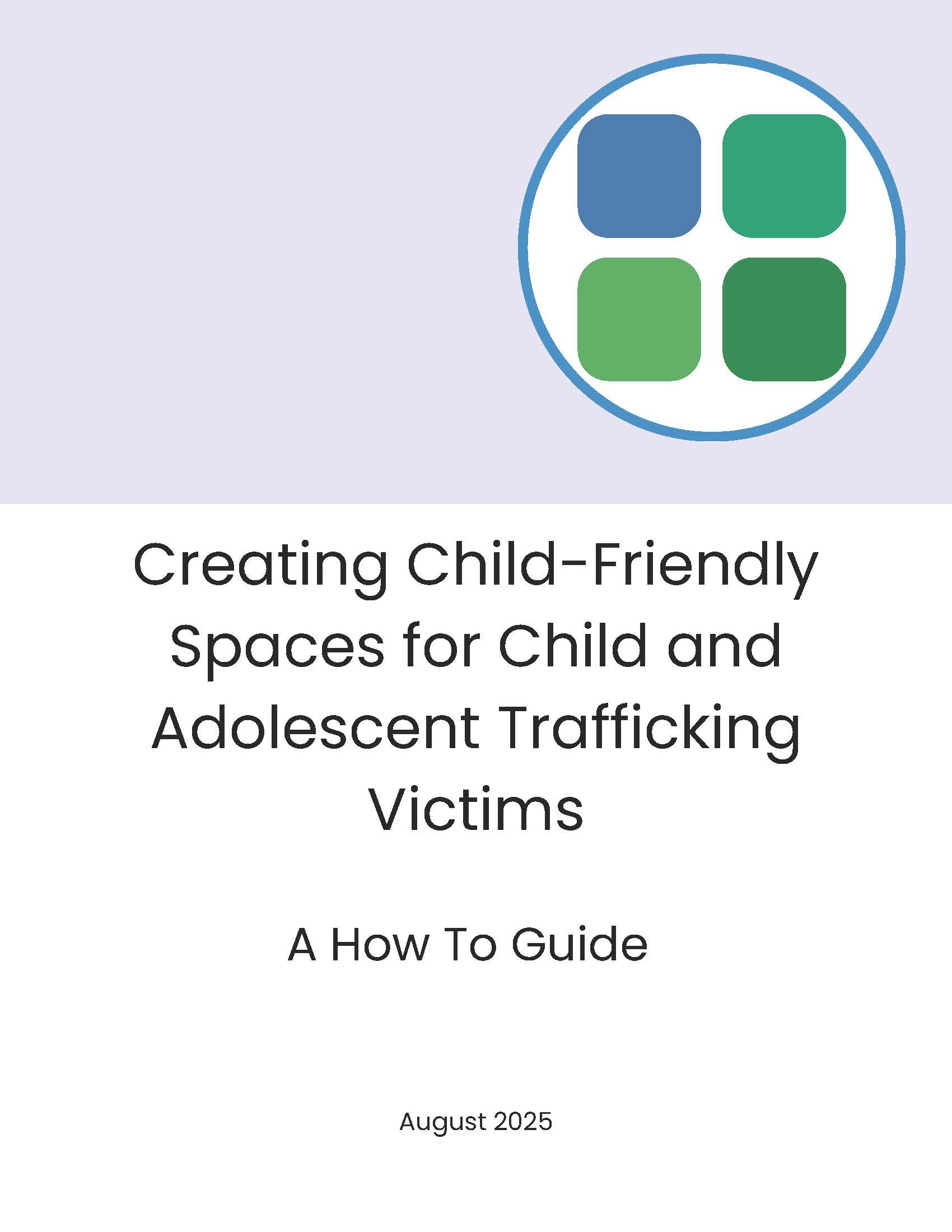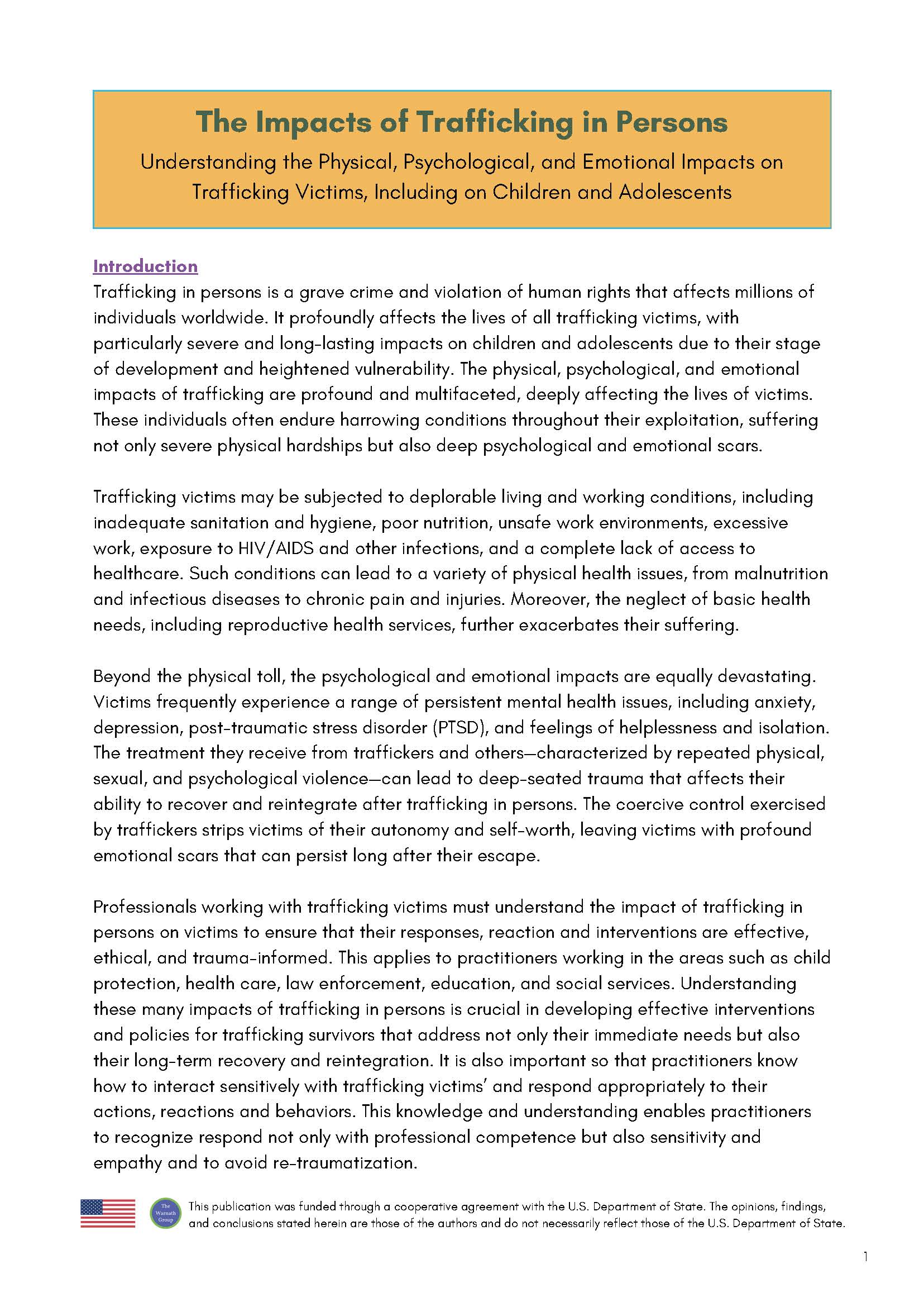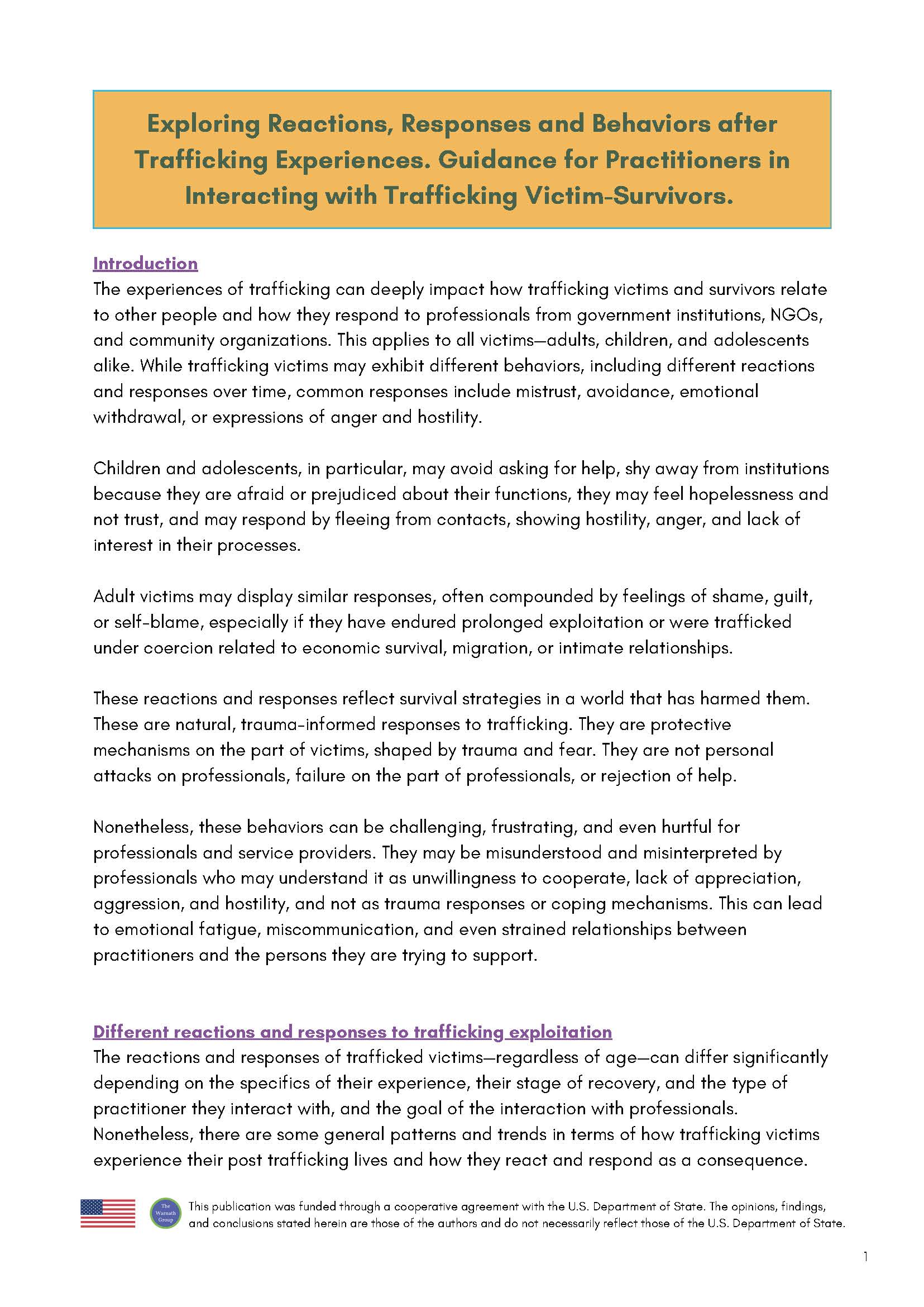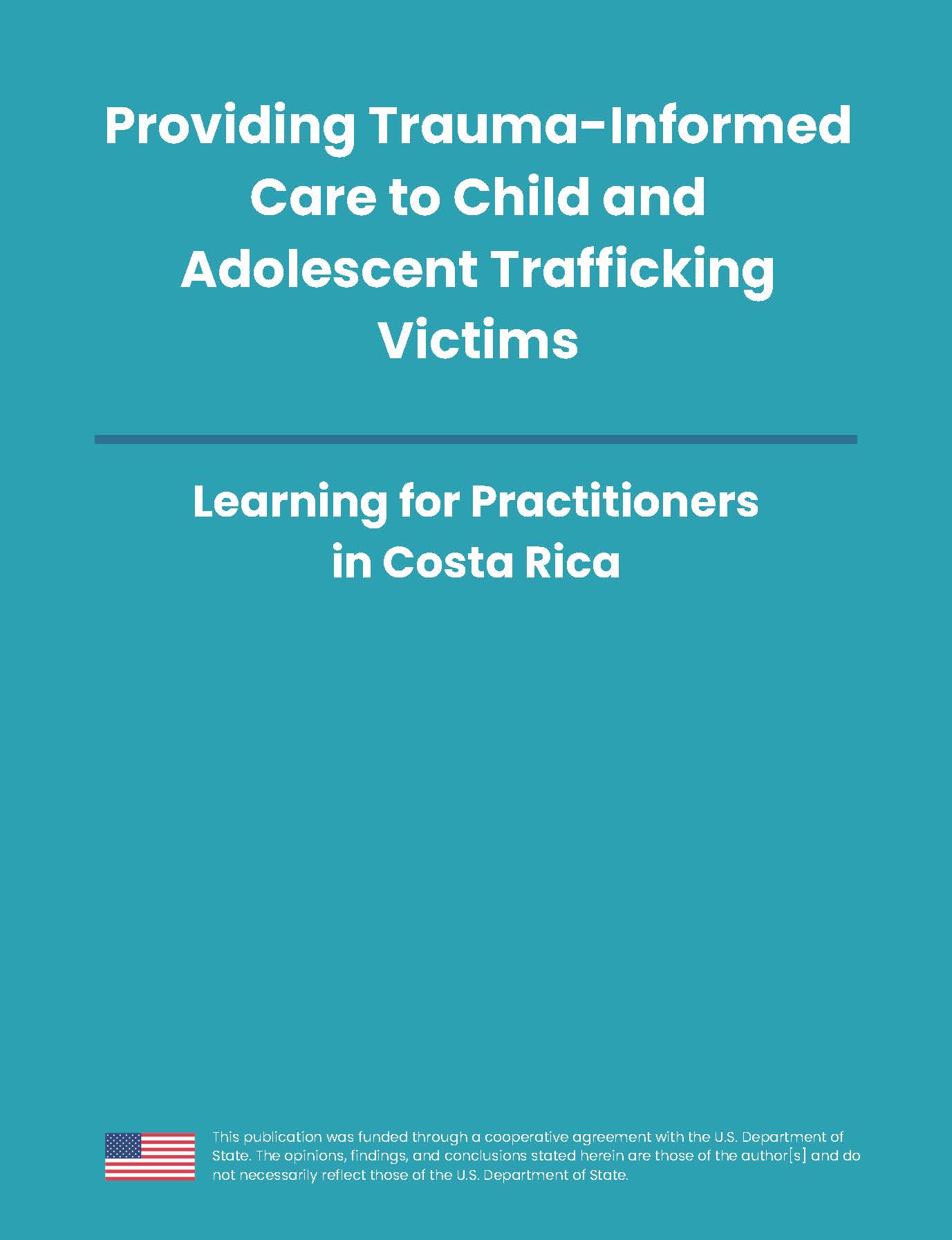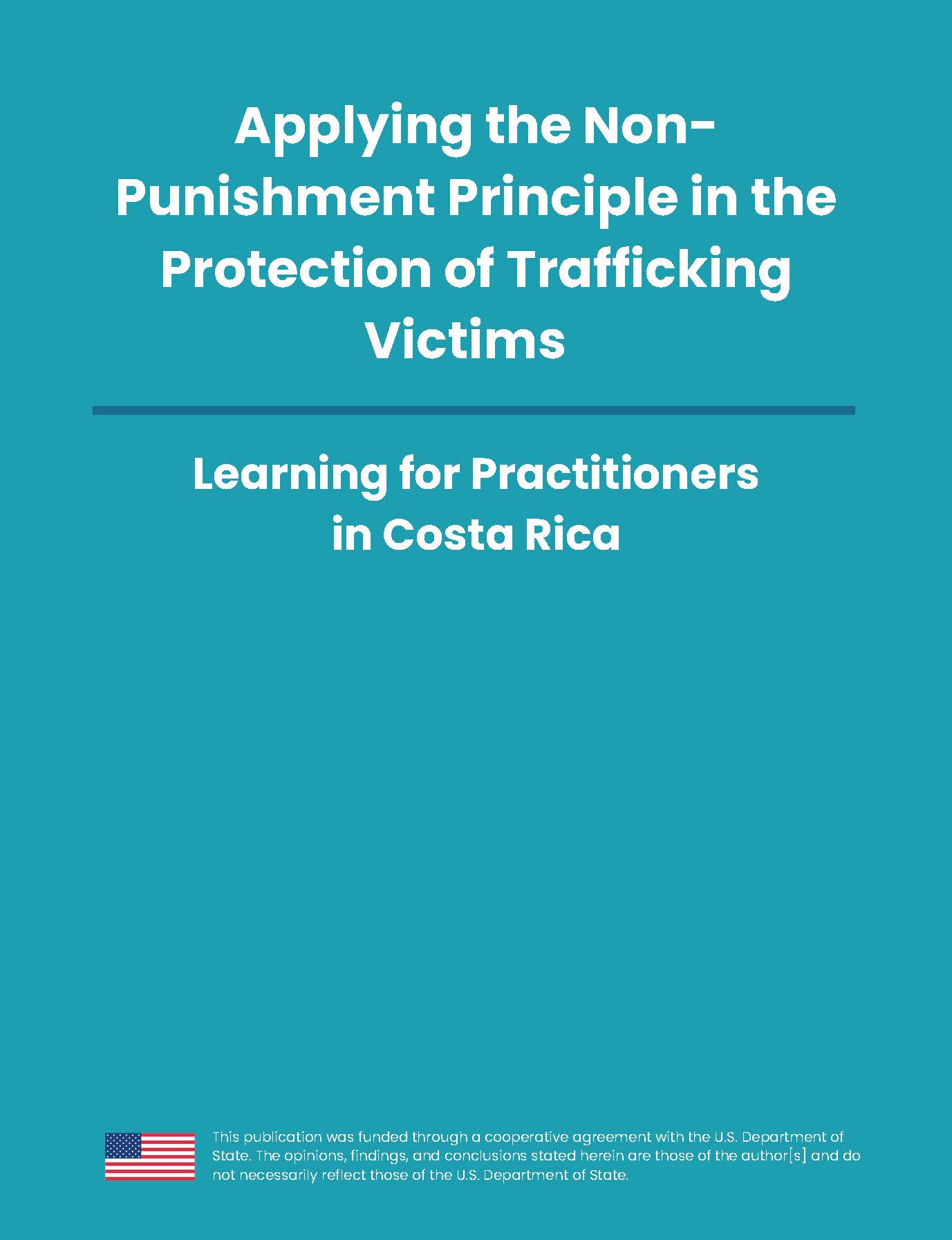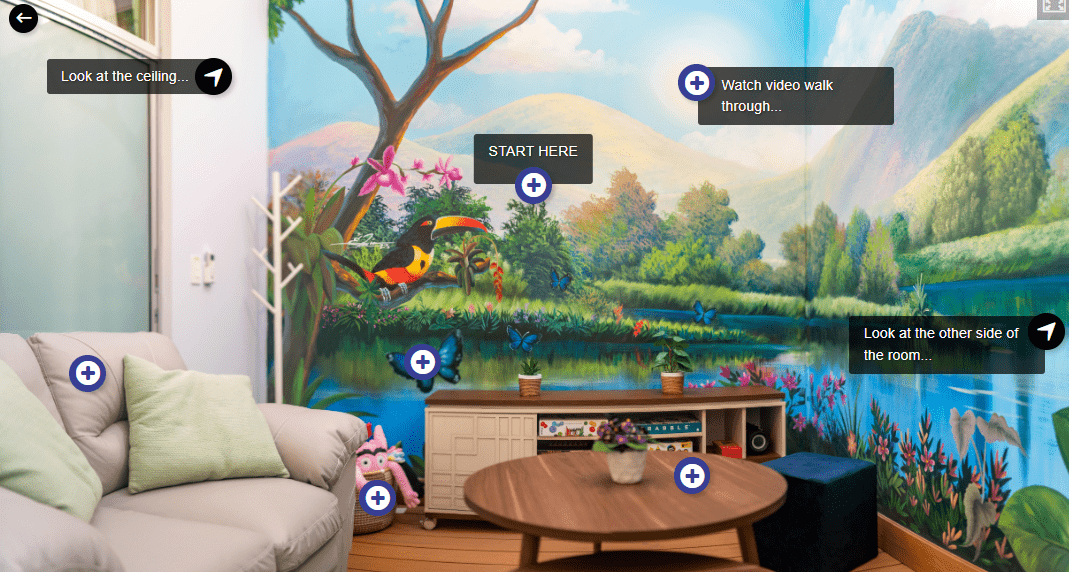Practitioner Platform
Welcome to the IACT Practitioner Platform. Here you can find a range of resources and tools to support your work protecting trafficking victims, prosecuting trafficking crimes, and preventing trafficking in persons. Some resources and tools are for use by practitioners in their daily work to combat trafficking in persons. Other resource and tools have been designed specifically for children and adolescents.
These resources and tools align with national law and policy, including existing protocols and procedures, and were developed with the support of Government of Costa Rica institutions and bodies. These resources and tools have been implemented with government partners and NGOs in the provinces of Guanacaste and Puntarenas, as well as in San José over the course of the IACT Program.
Page Contents
What is trafficking in persons?
This video explains the legal definition of trafficking in persons in Costa Rica and provides examples of different exploitative situations that constitute trafficking in persons. The video also uses case studies to help the viewer recognize signals and situations that are trafficking in persons.
What is child trafficking?
This video explains the legal definition of child and adolescent trafficking in Costa Rica and provides examples of different exploitative situations that constitute child and adolescent trafficking. The video also uses case studies to help the viewer recognize signals and situations that are child trafficking.Directory of Services for Trafficking Victims: A Tool for Practitioners in Costa Rica
This Directory of Services is a resource for practitioners to use in their daily work when they encounter possible trafficking victims. It provides information about trafficking in persons in Costa Rica, how to preliminarily identify and refer possible trafficking victims for accreditation, protection and assistance and services available for trafficking victims and their families in Guanacaste, Puntarenas, and San José, including how to contact service providers.
Directory of Services for Child and Adolescent Trafficking Victims
IACT created this version of the Directory of Services tailored for children and adolescents so that they can learn about child and adolescent trafficking, the rights and entitlements of trafficking victims, and where to seek help for themselves or someone they know. Practitioners can share this version directly with children and adolescents and their families so that they have the information they need to reduce the risk of trafficking and to receive assistance and protection if needed.
Directory of Services for Trafficking Victims
IACT created this version of the Directory of Services tailored for adult trafficking victims so that they can learn about trafficking in persons, the rights and entitlements of trafficking victims, and where to seek help for themselves or someone they know. Practitioners can share this version directly with possible trafficking victims so that they have the information they need to receive assistance and protection.
Map of Available Services for Trafficking Victims in Costa Rica
This searchable Map of Available Services for Trafficking Victims in Guanacaste, Puntarenas, and San Jos provides contact information for government and NGO service providers by geographic location. These services are also listed in the Directory of Services.
Preliminary Identification and the Protection of Trafficking Victims in Costa Rica: A Handbook for Practitioners
This handbook is for practitioners working in public institutions or non-governmental organizations who, through their day-to-day work, may come into contact with possible trafficking victims, including children and adolescents. The handbook was developed in the framework of IACT’s activities with government institutions through Multidisciplinary Teams (MDTs) such as Local Subsystems of Protection (SSLPs) to increase and improve the preliminary identification of possible trafficking victims and their referral for formal identification, protection and assistance, and reintegration services. It provides information to support and enhance a comprehensive victim protection response in line with Law 9095.
Indicators of Trafficking in Persons
Trafficking indicators are signs or signals that someone may be a trafficking victim. Indicators are an important tool in preliminarily identifying possible trafficking victims. Every practitioner plays a critical role in preliminarily identifying possible trafficking victims and referring them for formal identification and ensuring that they receive the services and support that they need to recover from trafficking. This handout includes different types of indicators of trafficking in persons: behavioral indicators, physical indicators, situational indicators, and community-based indicators. These indicators include those from the CONATT Model of Comprehensive Care for Survivors Who are Victims of the Crime of Human Trafficking.
Information for Trafficking Victims: Rights and Entitlements for those Cooperating in Trafficking Investigations and Prosecutions
This handout is for trafficking victims who are considering cooperating in trafficking investigations and prosecutions. It explains what trafficking in persons is and includes information about their rights and entitlements as a trafficking victims, including access to services. It also explains what participating in an investigation or prosecution entails, the rights and entitlements of victim-witnesses, protections for trafficking victims who decide to cooperate in investigations and prosecutions, and which institutions support trafficking victim-witnesses. While the handout is written for trafficking victims, practitioners may also use it to explain and share information with trafficking victims who are considering cooperating in trafficking investigations and prosecutions.
KitViSS (Kit for a Safe and Healthy Life: Resources for Children about Trafficking in Persons)
A child-friendly and age-appropriate platform developed for children from 8-13 years of age to learn about trafficking in persons, how to identify risks, and where to get help. KitVISS is a facilitated platform, which means that it should be used by education professionals in working with children. The KitViSS platform is accompanied by a Facilitator Guide for education and child protection specialists to understand how to educate children on trafficking in persons with the KitViSS platform and materials.
IACTjoven (IACT for Youth)
An adolescent-friendly and age-appropriate platform developed for adolescents from 13+ years of age to learn about trafficking in persons, how to identify risks and where to get help. The IACTjoven platform is a platform designed for use by adolescents themselves. It is also accompanied by a Facilitator Guide for education and child protection specialists to use IACTjoven as a facilitated platform to educate adolescents on trafficking in persons.
Creating Child-Friendly Spaces for Child and Adolescent Trafficking Victims – A How-To Guide
This easy-to-use resource provides a practical five-step overview of how to set up a child-friendly space (or multiple child-friendly spaces) for child and adolescent trafficking victims in your institution or organization. It discusses: determining if you need a child-friendly space for child and adolescent trafficking victims; identifying the rooms or areas utilized by child and adolescent trafficking victims; selecting and planning rooms or areas to be developed into child-friendly spaces; designing child-friendly spaces; and ensuring practitioners utilizing the space have received training on the protection of child and adolescent trafficking victims.
About Child-Friendly Spaces – Working with Child and Adolescent Trafficking Victims in Costa Rica
This resource offers guidance on using different child-friendly spaces in work with child and adolescent trafficking victims. It explains what a child-friendly space is, who it is for, and why it is important. The resource also outlines the criteria of a child-friendly space for child and adolescent trafficking victims, the IACT Program approach to operating a child friendly space (focusing on space, staff, standards, sustainability), and how to use a child-friendly space in working with child and adolescent trafficking victims.
Child-Friendly Spaces Virtual Tour
This is a virtual tour of four different child-friendly spaces developed by the IACT Program in Costa Rica, in partnership with Government of Costa Rica institutions. This virtual tour allows the user to visit the different spaces developed for children and adolescents in a PANI office, a hospital, and a prosecutor office and learn about the different components within these spaces that are designed to make the space safe, calm, and comfortable for child and adolescent trafficking victims.
The Impacts of Trafficking in Persons: Understanding the Physical, Psychological, and Emotional Impacts on Trafficking Victims, Including on Children and Adolescents
Professionals working with trafficking victims must understand the impact of trafficking in persons on victims to ensure that their responses, reactions, and interventions are effective, ethical, and trauma-informed. Understanding the many impacts of trafficking in persons is crucial in developing effective interventions and policies for trafficking survivors that address not only their immediate needs but also their long-term recovery and reintegration. It is also important so that practitioners know how to interact sensitively with trafficking victims and respond appropriately. This resource provides practitioners with an overview of the most common impacts of trafficking in persons – physical, psychological, and emotional – so that they are equipped in their daily work and interactions with trafficking victims.
Exploring Reactions, Responses and Behaviors after Trafficking Experiences: Guidance for Practitioners in Interacting with Trafficking Victim-Survivors
The experiences of trafficking in persons can deeply impact how trafficking victims and survivors relate to other people and how they respond to professionals from government institutions, NGOs and community organizations. This applies to all victims – adults, children, and adolescents alike. While trafficking victims may exhibit different behaviors, including different reactions and responses over time, common responses include mistrust, avoidance, emotional withdrawal, or expressions of anger and hostility. These behaviors can be challenging, frustrating, and even hurtful for professionals and service providers and may be misunderstood and misinterpreted by professionals. This resource provides an overview of different reactions, responses, and behaviors exhibited by trafficking victim-survivors and guidance for professionals in how to respond in effective, ethical, and trauma-informed ways.
Providing Trauma-Informed Care to Child and Adolescent Trafficking Victims: Learning for Practitioners in Costa Rica
Most child and adolescent trafficking victims suffer from trauma. This trauma may not only be the result of having been trafficked, but also from the difficult conditions that precede and follow their trafficking experience. Trauma-informed care (TIC) is a framework that guides how professionals and institutions understand, respond to, and support individuals who have experienced trauma, including child and adolescent trafficking victims. Providing trauma-informed care means recognizing the widespread impact of trauma, understanding potential paths for recovery, and integrating that awareness into every aspect of service delivery, from policies and environments to interpersonal interactions. This resource explains trauma-informed care and explores some of the challenges faced by practitioners in implementing trauma-informed care in working with child and adolescent trafficking victims – structural challenges rooted in limitations of the system and challenges stemming from the inherent complexity of working with severely traumatized children and adolescents. It also explores different solutions and strategies in addressing these challenges and implementing trauma-informed care with child and adolescent trafficking victims.
Applying the Non-Punishment Principle in the Protection of Trafficking Victims: Learning for Practitioners in Costa Rica
Victims of trafficking in persons may be involved in a range of unlawful activities as a direct result of being trafficked – for example, for immigration or document-related violations, violations of labor regulations while being exploited, or prostitution-related offenses in countries where prostitution is illegal. As a consequence, they risk being punished as offenders rather than protected as victims of trafficking in persons. To mitigate these risks, the non-punishment principle sets out that victims of trafficking in persons should not be prosecuted or otherwise punished for unlawful acts they commit as a direct consequence of being trafficked. This resource explores the challenges that arise in the application of the non-punishment principle in the protection of trafficking victims in Costa Rica, at identification, during an investigation, during prosecution, and during adjudication. This resource provides practical guidance for practitioners to understand and recognize the nexus between a person’s trafficking experience and their offending and how that nexus serves as a basis for applying the non-punishment principle. This resource also offers concrete solutions and measures to more effectively apply the non-punishment principle in practice.
Understanding Vicarious Trauma and Professional Self-Care in Working with Trafficking Victims including Children and Adolescents: Learning for Practitioners in Costa Rica
Working with individuals who have endured deep traumatic experiences, such as victims of trafficking in persons, requires professionals to engage empathetically with intense suffering. This sustained emotional involvement can lead to psychological and emotional consequences among professionals. Understanding vicarious trauma is a critical first step in a professional’s ability to self care and protect their health and well-being. By extension, this allows practitioners to build healthier and more sustainable support environments for the trafficking victims that they work with. This resource explains vicarious trauma and how it impacts practitioners who work with trafficking victims, including children and adolescents. It also explains the challenges that prevent effective responses to vicarious trauma, including personal challenges for practitioners, as well as those that are systemic and inherent to the nature of trauma-exposed work. This resource then provides guidance on how to prevent and manage vicarious trauma through awareness, as well as intentional, sustained self-care practices to protect emotional health and well-being.

Developed by and © 2025 Warnath Group, LLC ![]() . All Rights Reserved.
. All Rights Reserved.
The development of the IACT Learning Hub was funded through a cooperative agreement with the U.S. Department of State. The opinions, findings, and conclusions stated herein are those of the developers and do not necessarily reflect those of the U.S. Department of State.
Sitemap • Privacy Policy • Terms of Use • About the IACT Program ![]()
